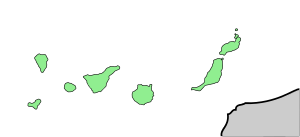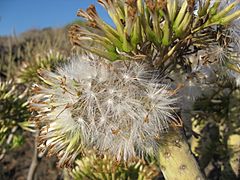Kleinia neriifolia facts for kids
Quick facts for kids Kleinia neriifolia |
|
|---|---|
 |
|
| Conservation status | |
| Scientific classification | |
| Genus: |
Kleinia
|
| Species: |
neriifolia
|
 |
|
| Native range of K. neriifolia. | |
| Synonyms | |
|
Senecio kleinia Less. |
|
Kleinia neriifolia, known in Spanish as verode or berode, is a species of flowering plant in the daisy family (Asteraceae). It is endemic to the Canary Islands. It was formerly named Senecio kleinia.
Contents
Description
A succulent plant, Kleinia neriifolia has articulated branches (constrictions that make them look like rows of sausages) and thick, stubby, elongated leaves up to 12 cm (5 in) long which grow directly from the main stem or branch without a petiole or footstalk. The leaves grow clustered in crowded circles at the tops of the branches. Plants can reach 3 m (10 ft) or more. Fragrant grey white flowers appear at any time between March and October. The plant is deciduous, the leaves falling at the beginning of the dry season. As with many succulents, reproduction by cuttings is possible.
Habitat
Kleinia neriifolia grows abundantly in the Tabaibal-Cardonal zone or the arid, subtropical areas, often with steep and eroded substrates which are more pronounced and dominant in the eastern archipelago. The vegetation can be compared with that of the arid areas of Sudan, Ethiopia, Arabia and Iran and is typical of the steppe in the African continent.
Horticulture
The plant is used in gardens with dry conditions. The plant requires a minimum exposure to the sun. The minimum winter temperature it can endure is −2 °C (28 °F).
Kleinia neriifolia has been successfully cultivated as a houseplant and as landscaping. It is on a list of suggested fire safe landscaping.
See also
 In Spanish: Verode o verol para niños
In Spanish: Verode o verol para niños





